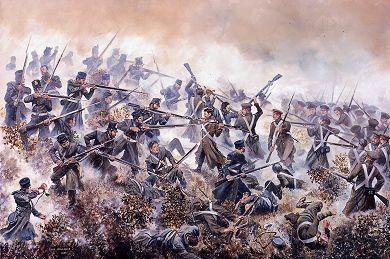|
|||
|
Philatelia.Net / Fragments of Russian History / Plots / The directory «Plots»The Battle of InkermanThe Battle of Inkerman, a battle of the Crimean War, was fought on November 5, 1854 and resulted in a British and French victory under General Pierre Bosquet against the Russian forces under General Menshikov. In this battle British soldiers fought bravely under the remote leadership of Lord Raglan. The battle was eventually won by a counter-offensive by the French soldiers under General Bosquet. George B. McClellan wrote in "Armies of Europe" 1861: "As things went at Inkermann, the result, as far as the English were concerned, appears to have been due to that steady and magnificent courage of their races, which has so often palliated or overbalanced the follies and unskillfulness of their commanders, whether in victory or defeat. Their conduct on that day was worthy of the nation which gained credit alike at Malplaquet and Landen, Blenheim and Fontenoy, Waterloo and Corunna. The position of Inkermann is the key point of the northeastern angle of the plateau of the Chersonese; it commands the road ascending the plateau by Cathcart's ravine, the only approach from the north side, and the road which follows the Careening Bay ravine, the only approach from the city in that vicinity; it is the most elevated ground in the neighborhood, and is susceptible of strong defense from whatever direction it may be attacked. If the Russians had occupied it, the siege of the Karabelnaia would have become impossible, and the position of the allies dangerous in the extreme; if strongly occupied by the allies, the right flank would have been perfectly secure. Could the Russians have anticipated a siege of Sebastopol, it would have been an unpardonable error not to have occupied the Inkermann by a small permanent work. How little they were prepared for an attack by land will probably be shown in the sequel; but, as things were, it appears to be a grave error not to have entrenched the position from the beginning. It was still more inexcusable on the part of the allies to have omitted the occupation of the position in force; nor, with proper field works, would a very large force have been necessary. The Russian plan for the battle of November 5 was most excellent in conception; and, as far as mere orders can go, nothing seemed wanting to insure success, and drive the English partly over the steep borders of the plateau into the open arms of Gorchakov, partly into the sea, and the rest to Kamiesch. It must be kept in view that the principal object of the Russians in giving battle at the Inkermann was to prevent an assault upon the town, then regarded as too weak to resist it: in this respect, although at a heavy cost, they gained their point, for they effectively rendered an assault impossible for many months thereafter. In considering the plan of attack, the Russian general rejected the idea of a movement on the Allied centre, (by the ravine of the inner harbor,) because it was too effectively defended by the siege batteries of the allies; the attack upon their rear was rejected because the plateau was very difficult of access, strongly guarded, and the affair of Balaklava had induced the allies to throw up works in that direction. It was therefore determined to attack the English right and centre, making false attacks on the French left and towards Balaklava. The spirit of the orders issued was as follows: General Soimonov with 16,200 infantry and 38 guns, to march up the Careening Bay ravine, ascend its western slope near the Victoria redoubt, and attack the English centre. General Pauloff, with 13,500 Infantry and 28 guns, to march from the north side, descend into and cross the Tchernaya valley at the head of the Bay, ascend by Cathcart's ravine, and attack the English right; the attack of these two commands to be simultaneous. General Gorchakov, with about 15,000 infantry, 4,000 cavalry, and 40 guns, to make a false attack upon Balaklava and the roads leading thence to the plateau. General Timofeyev, with some 2,500 men and 4 guns, to make a false attack upon the French left, carrying their batteries, if any confusion were observed among them. The batteries in the town to keep up a warm fire. A close examination of the ground would indicate propriety of this plan of attack; the difficulty arose in the execution. It would appear that in the orders the expression left of the Careening Bay ravine was used for western; Soimonov improperly interpreted this as meaning his own left, and thus brought his own and Pauloff's column into the state of confusion which paralyzed the efforts of both, so that but a portion of either command was at any one time engaged. As it was, the Russians were undoubtedly driving the exhausted English before them when Bosquet came up. Had the false attack towards Balaklava been properly conducted, Bosquet would have been unable to assist the English; but, soon perceiving that the operations of Gorchakov were confined to a simple cannonade at long-range, he readily divined the true state of affairs, and by his prompt action saved the army. Timofeyev succeeded in spiking 15 guns, and paralyzed the French left. It would thus seem that the result of the action was due partly to the courage of the English, partly to the mistake of Soimonov, who expiated his error with his life, partly to the prompt and correct judgment of Bosquet, and mainly to the fact that Gorchakov did not conduct his false attack with sufficient energy and decision. The desperate courage of the Russians in this affair was fully acknowledged by all who participated in it." Kiribati, 2006, Beach rescuing Col. Carpenter Tanzania, 1999, Battle of Inkerman Great Britain, 2004.10.12, Advertising: |
|||
© 2003-2024 Dmitry Karasyuk. Idea, preparation, drawing up
|

